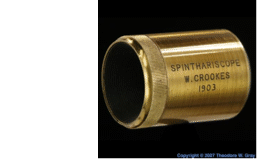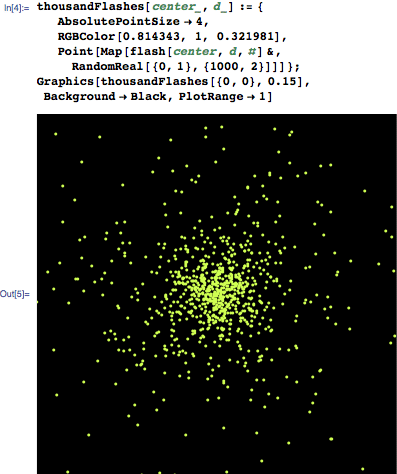A Thousand Points of Light
The spinthariscope, invented and beautifully named by William Crookes in 1903, is a device for seeing individual atoms. Or at least, seeing the death of individual atoms.
A spinthariscope consists of a needle, similar to a watch hand, positioned in front of a zinc sulfide luminous screen, with a magnifying glass focused on the screen. At the end of the needle is a small patch of radioactive material. Originally radium was used; more recently polonium, uranium and americium have been found to be safer.
This is a particularly attractive brass model in my collection:

Despite the engraved date it was probably made in the 1920s. The lens is on the left, and can be focused by sliding the two sections of the barrel back and forth.
When you look into the lens, you see thousands of flashes of light on the zinc sulfide screen. Each flash of light comes from the radioactive decay of a single atom of radium. It’s often described as a swarming sea of light, and it was a significant scientific discovery at the time. Never before had it been possible to unambiguously observe the effects of individual atoms, one at a time.
Looking into a spinthariscope is quite a marvelous experience, but there are certain disadvantages. First, they are radioactive, and you’re putting your eye up very close. An antique spinthariscope, like the one pictured above, can be quite “hot.” This one was contaminated inside and out with strongly radioactive dust, a combination of radium paint flaking off the needle and radium decay products emitted from the source and accumulated inside the barrel over nearly a hundred years. Modern uranium ore or americium button-based spinthariscopes are not dangerously radioactive and the sources are well sealed, but still.
The other problem is that the flashes of light are at the very extreme lower end of human visual sensitivity. You have to sit in a pitch black room for a good ten minutes before your eyes become sensitive enough to see them at all. (While this can be inconvenient for casual viewing, it is rumored to have been one of the factors leading to the popularity of these devices in certain circles during the late Victorian era. If you brought one to a fine dinner party, you had an excuse to ask the ladies to come sit in a dark room with you for, well, at least ten minutes. That was pretty hot stuff during a time when even piano legs were draped for modesty.)
Anyway, when I wrote an article about spinthariscopes for my Popular Science column, I needed a way to show in print what the inside of a spinthariscope looks like. Photographing brief flashes of light barely visible to the human eye is surprisingly difficult. No ordinary camera can do it, and even commercially available night vision scopes are not good enough.
While it’s probably possible to do with highly specialized equipment, I decided that creating a scientifically accurate simulation would be a better alternative for creating an image for my column. Needless to say, I used Mathematica to create that simulation.
Here’s a picture of the situation, made with the Graphics3D function in Mathematica:

Alpha particles from the radioactive source are emitted in random directions. Those that hit the screen result in a flash of light. This code gives the coordinates of such a particle.
![In[1]:=flash[center_, d_, {\[Phi]_, \[Theta]_}] := (center + d Tan[ArcCos[2 \[Phi] - 1]] {Cos[2 \[Pi] \[Theta]], Sin[2 \[Pi] \[Theta]]}) In[1]:=flash[center_, d_, {\[Phi]_, \[Theta]_}] := (center + d Tan[ArcCos[2 \[Phi] - 1]] {Cos[2 \[Pi] \[Theta]], Sin[2 \[Pi] \[Theta]]})](https://content.wolfram.com/sites/39/2021/01/particlecode.gif)
Here’s what a thousand flashes emitted 0.15 units above the surface look like:

This is mathematically fine, but doesn’t look at all like a real spinthariscope. So, with a couple of simple adjustments, I made the dots light on a black background:

Why this color? It’s my subjective impression of the color of a zinc sulfide luminous screen. Which I swear is what I remember seeing in real spinthariscopes, until someone pointed out that, of course, at those dim light levels you can’t see color at all. In fact, spinthariscope views (like all very dim phenomena) look black and white. But this is the color that a zinc sulfide screen looks like when it’s lit with a strong enough radioactive source to make it glow brightly, rather than just emit scattered individual flashes (this is how old radium watch hands work). I decided to stick with this color even though it’s more psychological than real.
The next refinement is to take into account that the luminous screen is typically round: any alpha particles striking outside the round area will not be visible. This is simulated by selecting only those points that lie within a certain distance from the center.
Then, we add the silhouette of a watch hand over these points of light. I wanted a pretty watch hand, so the first thing I did was create a little tool for designing a watch hand:
That Demonstration (you can download a live version and access the source code here) lets you drag around the blue control points to reshape the watch hand, while providing a continuously updated mirror reflection of the line, which is indispensable for judging the appearance of the hand.
Maybe there’s a way to do that in Adobe Illustrator, but I sure don’t know how. (Sure, you could draw the spline curve, but could you have the mirror image updated in real time? Without that you’ll spend hours fiddling to get it right.)
The “paste snapshot” feature of Manipulate can be used to extract the hand, and a bit of processing turns it into a flat list of coordinates defining the hand.
Now we have all the elements we need to assemble an interactive spinthariscope simulator, which allows you to move the hand across the screen sideways (as you can using a small thumb wheel in my actual antique spinthariscope), and also closer and farther from the screen (which you can’t do with the real one). I even added an option that makes the flashing continuous, so it doesn’t just flash when you move the hand. (Think about it: the tiny speck of radium in mine has been sending out thousands of flashes of light every second for almost a hundred years whether anyone was looking at it or not. It’s sitting on my shelf quietly flashing to itself right now, and it’s going to keep flashing for another ten thousand years before the radium has decayed to the point where there are just a few flashes per second.)
The complete, live Demonstration with all the controls and source code can be downloaded here.
So, there you have it—quite a nice, full-featured spinthariscope simulation.
As is typical in these situations, 90% of the complexity comes from the last 10% of polish. The watch-hand silhouette requires several times as much code as the rest of the simulation put together. That’s one reason “real” examples can seem so much longer and more complicated than case studies designed to show off a particular feature.
For comparison, here is a completely self-contained version of the spinthariscope simulation, showing off just how compact and efficient Mathematica code can be:








